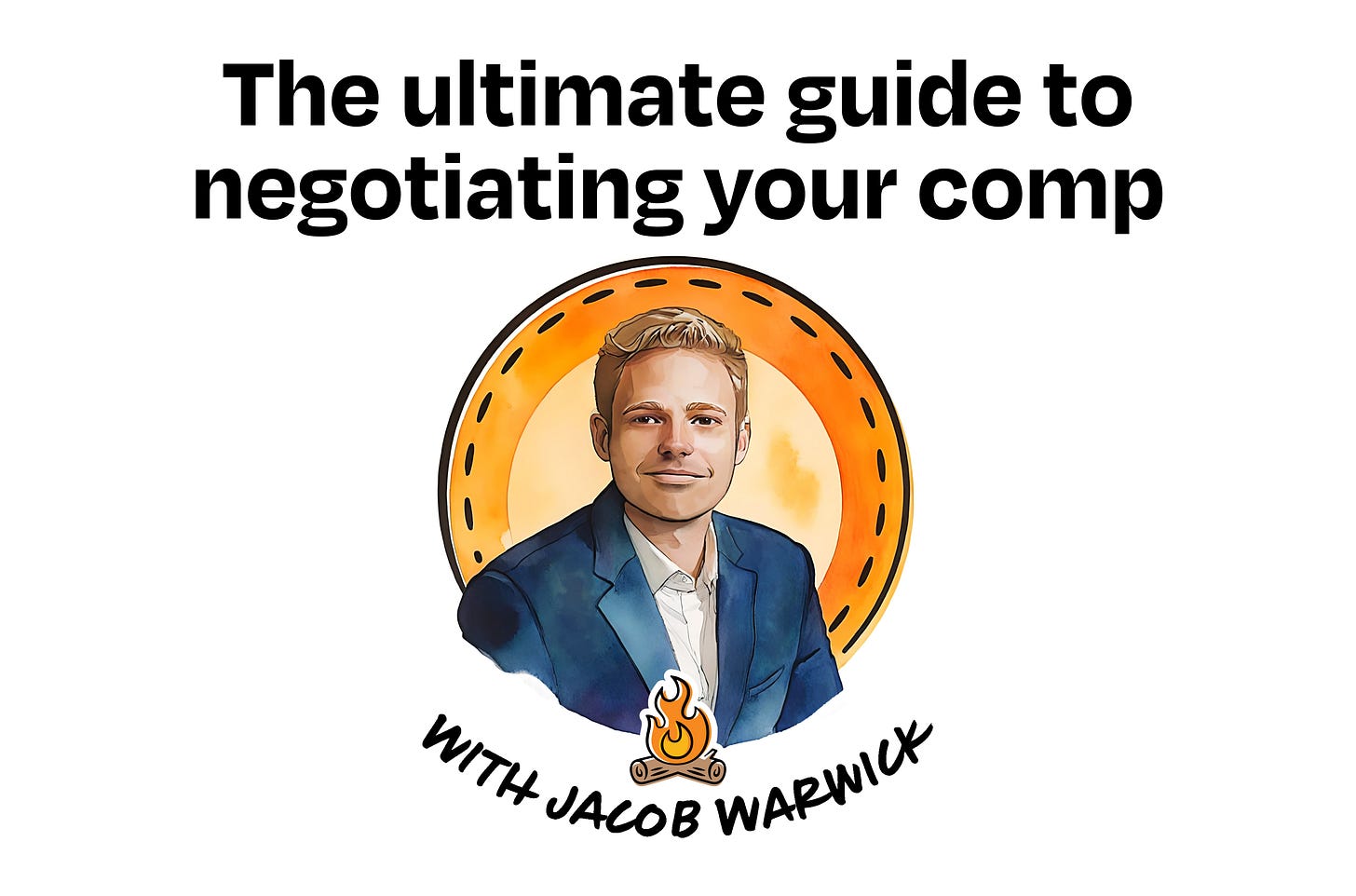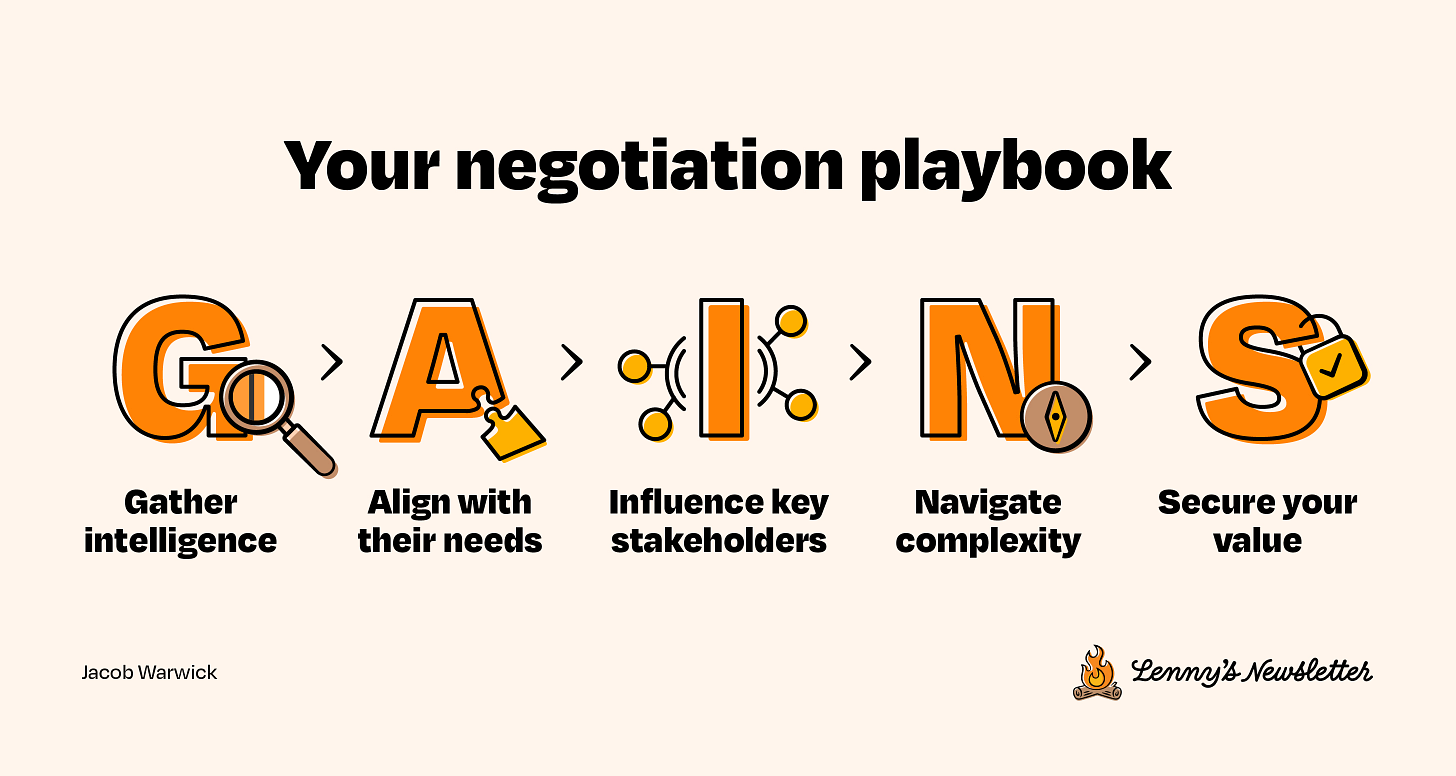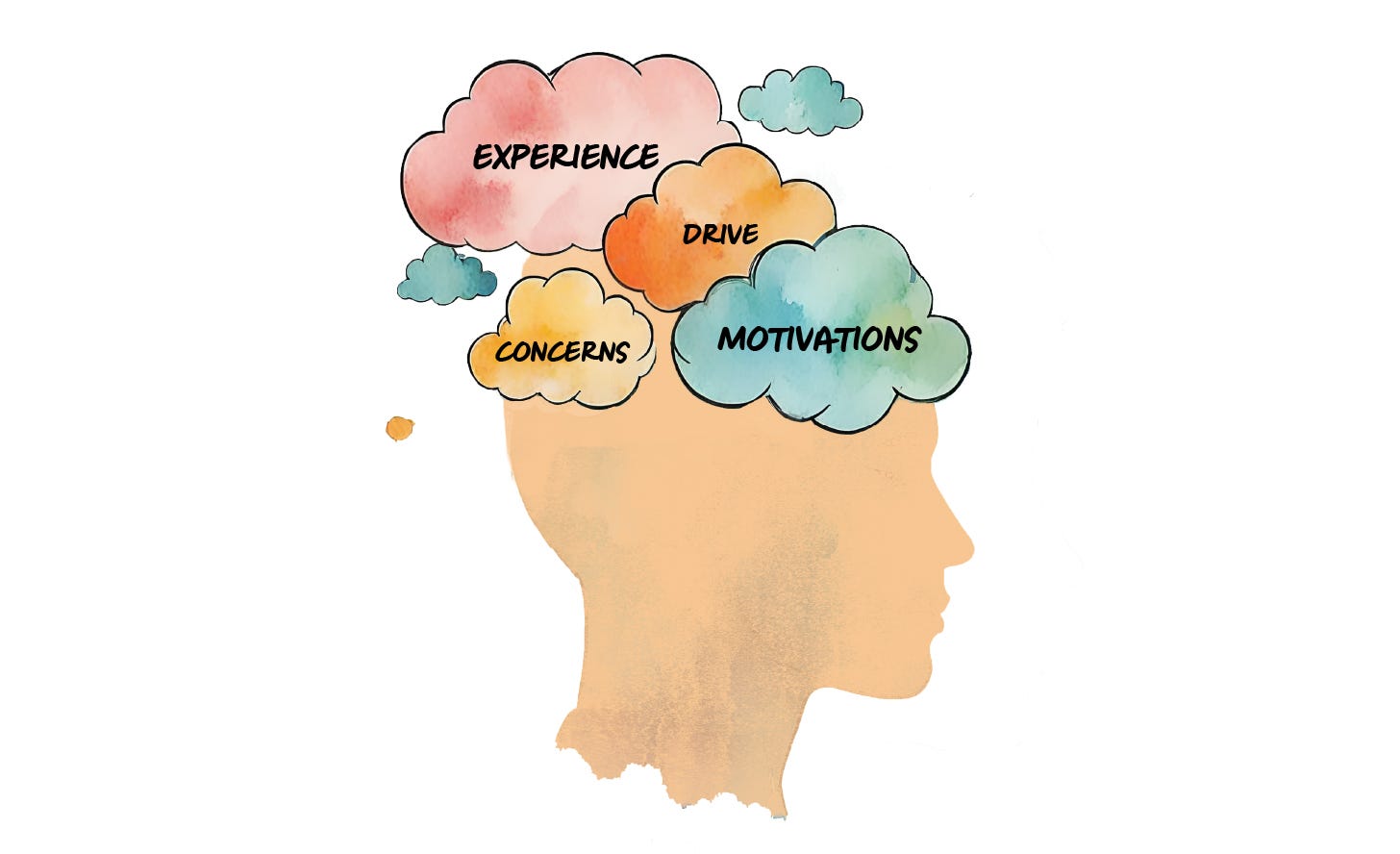The ultimate guide to negotiating your comp
The step-by-step guide that’s helped hundreds of leaders secure life-changing compensation
👋 Welcome to a 🔒 subscriber-only edition 🔒 of my weekly newsletter. Each week I tackle reader questions about building product, driving growth, and accelerating your career. For more: Lenny’s Podcast | How I AI | Lennybot | Lenny’s Reads | Courses | Swag
Annual subscribers now get a free year of Perplexity Pro, Notion, Superhuman, Linear, Granola, and more. Subscribe now.
I’m excited to share the most practical and specific guide to negotiating comp that I’ve ever seen. This approach is targeted at leaders (e.g., senior ICs and managers), but no matter your role, anyone can benefit from this incredibly pragmatic, direct, and practical collection of tactics and advice.
A bunch of my trusted friends have been raving about Jacob Warwick, a full-time negotiation coach for executives. Over the last 10+ years, he’s guided more than 3,500 senior leaders through high-stakes comp negotiations. This post is a synthesis of everything he’s learned over the past 15 years. You won’t find anything like this elsewhere.
For more from Jacob, check out his free LinkedIn profile analysis tool, which just went live on Product Hunt today, his interview preparation report service, and his individual consulting services at ThinkWarwick Global. You can also find him on LinkedIn and X.
P.S. If you prefer, you can listen to this post in podcast form: Spotify / Apple / YouTube
Two equally qualified product leaders walk into the same negotiation. One leaves with a standard package—market-rate base salary, typical equity, standard benefits. The other walks away with double the compensation, accelerated vesting schedules, and a signing bonus that covers their mortgage for a year.
The difference isn’t skill, experience, or even negotiation tactics. It’s a fundamental shift in approach. As a product leader, you already understand that successful products solve important problems for people, create emotional connection with their users, and meet real market needs. Exceptional negotiation works the same way.
While most candidates ask, “What can you offer me?,” top earners demonstrate “Here’s how I’ll solve your most pressing challenges and create new possibilities for your business.”
Demonstrating unmistakable value for the company you’re interviewing with, and building relationships with the people who matter, will create opportunities others never see and transform your compensation trajectory.
This shift isn’t semantic—it fundamentally transforms how decision-makers perceive your value. When you make them feel confident, inspired, and excited about the future you’ll build together, compensation becomes a natural reflection of that value, not a negotiation point.
Recently, I guided a Senior PM whose offer started with an advertised range of $185K-$285K. After our targeted interview and negotiation strategy, they walked away with a staggering $1.1M annual package—nearly four times the upper limit. This isn’t an isolated success. I’ve helped hundreds of leaders dramatically increase their compensation by refusing to accept published salary ranges as the final word.
I’ll show you exactly how they do it.
Your negotiation playbook
Every successful negotiation starts with leverage. Whether you’re planning six months ahead or sitting in discussions right now, here’s the process I’ve developed through trial and error with clients over 15 years.
G: Gather intelligence. Go beyond the obvious. Dig into the company’s real challenges, understand who truly makes decisions (hint: it’s not always on the org chart), and know their market better than they do.
A: Align with their needs. Stop selling your resume. Start demonstrating how you’ll solve their specific problems for the company/team. When you position yourself as the solution to their challenges—not just another candidate—the power dynamic shifts immediately.
I: Influence key stakeholders. Create champions throughout the organization, not just with the hiring manager. Show each stakeholder how you’ll make their world better, and they’ll fight for your compensation later.
N: Navigate complexity. Master the delicate dance of pushing for what you’re worth without creating tension. Know exactly when to advance discussions and when to build relationships. Timing is everything.
S: Secure your value. Get agreements right, start delivering value before day one, and build the foundation for your long-term success.
Let’s break down exactly how to execute each step with real examples from leaders I’ve worked with who have used this approach to dramatically increase their compensation.
G: Gather intelligence that others miss
The most valuable information won’t show up in press releases or job descriptions. To build real leverage, spend time on three key intelligence domains:
1. Organization dynamics
Forget the org chart—real power flows through history, unspoken alliances, and relationships.
Approach:
Identify who gets consulted before decisions are made (often not who you’d expect)
Learn which past failures still haunt leadership thinking
Discover which rising stars have the CEO’s ear
Uncover the true drivers that aren’t discussed openly
Real-world impact: I watched a brilliant SVP candidate lose an $800K opportunity by making one critical mistake. They treated the Chief of Staff meeting as a formality while focusing all their energy on impressing the CEO. They never realized this “assistant” whispered in the CEO’s ear about every executive hire. Meanwhile, the candidate who got the job built genuine rapport with both, understanding the real power dynamic at play.
How to execute this: Before any interview, ask your network, “Who really influences decisions at this company?” and “Whose opinion does the leadership team value most?” The answers might surprise you.
During the interview, ask questions such as:
How are decisions typically made in this organization?
Who are the key people I will collaborate with?
What’s the history behind this position? Is it new or am I replacing someone?
How can I best show up for you? And how can I best show up for [name other team member(s)]?
2. Decision-maker psychology
Decisions are made by people. Understand what drives them.
Approach:
Research what motivates each key player both professionally and personally
Identify formative experiences that shaped their leadership philosophy
Discover what problems truly keep them awake at night
Learn how they measure success beyond the obvious metrics
Real-world impact: My product-executive client secured a $1.8M package after we discovered that their future CEO consistently bet on leaders who had overcome significant failures. While other candidates showcased perfect track records, we strategically shared growth from setbacks—creating an immediate connection that moved beyond their credentials.
Script that worked: When speaking with the CEO, my client shared, “That product launch failure taught me three lessons about market timing that completely transformed my approach. I’m curious—what experiences have most shaped your philosophy toward product leadership?” This led to an engaging brainstorming session with the CEO about product vision.
Consider the following starting questions:
What tough lessons has the company learned that changed how you do things now?
Why did you decide to hire for this role right now vs. waiting?
Can you tell me about a time when things didn’t go as planned and how the team handled it?
3. Strategic pain points
In order to speak directly to how you can add real value to the company, figure out which divisions are missing targets, which roles have been open too long, and what shifts are being debated behind closed doors—and how you would solve those problems.
Approach:
Track where the company is headed, not just where it’s been
Identify problems they’ll face six months from now
Understand which initiatives have underdelivered and why
Use your experience to form an opinion about what must be done
Real-world example: A client targeting a VP of Product Design role used this approach perfectly. Instead of relying on her impressive portfolio alone, she dug deep into the company’s challenges through industry contacts.
She discovered that while they consistently delivered on their roadmap, their products weren’t creating customer enthusiasm. Rather than focusing on her credentials in interviews, she “sold the vacation”—painting a vivid picture of their organization after her design transformation.
She detailed exactly how she would restructure product development, rebuild customer experience, and deliver measurable outcomes. The leadership team bought into the future she helped them envision. While other candidates matched the job description, she addressed their unspoken needs and secured a $1.2M package—double the stated range that topped out at $600K.
Gathering self-assessment
Before your next opportunity, assess your intelligence-gathering with these questions:
Organizational network analysis: Can you name at least three influential people not on the leadership team? If not, your research is still surface-level.
Decision-maker insight: For each key stakeholder, can you identify their professional background, leadership philosophy, and one challenge they’re currently facing? If gaps exist, deepen your research.
Information-source diversity: Review your research sources. If they’re limited to the company website, press releases, and LinkedIn, you’re missing crucial intelligence. Expand to industry forums, customer reviews, and first-degree connections.
Strategic pain-point clarity: Can you articulate the company’s three biggest challenges in their own language? If not, you haven’t yet uncovered what truly matters to them.
Competitive-position knowledge: Do you understand how they measure success against competitors? Can you name which metrics they’re winning on and which they’re trailing? If not, your market context remains incomplete.
The difference between adequate preparation and strategic intelligence often comes down to this: Are you gathering facts anyone could find, or are you uncovering insights that create a genuine competitive advantage?
A: Align with advocates
Now that you know the importance of collecting information, it’s time to use that intel to align with key people at the company, rather than impressing them. This isn’t semantics—it completely transforms the power dynamic.
Instead of proving yourself worthy, you’re evaluating mutual fit and demonstrating understanding.
I recently helped a product leader transform a Senior Director role with a range of $143K-$285K into a $1.1M package by shifting one fundamental approach. Instead of selling his credentials, we engaged the leadership team in discussions about how investing in strong product leadership would position their company as an industry innovator.
By focusing on their aspiration to be visionary, we changed how they perceived the role’s value, leading them to quadruple their initial compensation range.
Consider these contrasting approaches:
Weak: “I have 15 years of experience leading product teams and consistently exceeding targets. . .”
Strong: “Your challenges with product-market fit remind me of a similar situation at [Company]. We discovered that the root cause wasn’t our process but our customer development approach. I’m curious, how aligned are your product and research teams on an ideal customer profile?”
The weak response positions you as an applicant listing credentials. The strong response establishes you as a peer exploring solutions together.
This transformation happens through three critical elements.
1. Storytelling
Forget polished success stories and rehearsed scripts. Focus on raw, relevant experiences that create immediate connection.
Approach:
Connect your past challenges directly to their current problems
Share the messy middle of your experiences, not just outcomes
Focus on lessons learned that directly apply to their situation
Use stories as bridges to solutions, not as evidence of your greatness
Real-world impact: The aforementioned product executive client landed their new role by sharing a story about a failed product launch—not to showcase resilience but to demonstrate how that experience shaped their approach to due diligence, which mapped directly to their prospective employer’s current challenges.
The company recently went through a few failures of its own, and my client knew the CEO was motivated to avoid another mistake. They framed their experience learning from past missteps to ensure alignment with the CEO’s own goals.
Script that worked: When building alignment with the CEO, my client used the following frame: “That failed launch taught me to question three assumptions we never validated. Looking at your current roadmap, I’m concerned you might be facing similar blind spots with your enterprise expansion. Have you tested the assumption that enterprise users need all these features?”
Don’t be afraid to ask challenging questions to assess how well aligned you are with leadership. For example:
What’s a problem your team is stuck on right now that keeps coming back?
If you could solve one thing that’s broken in the company, what would it be?
What’s something you wish candidates would understand about this role that most don’t get?
2. Child-like curiosity
Big, bold questions that others may tiptoe around can demonstrate both competence and humility.
Approach:
Ask questions that reveal your strategic thinking
Challenge assumptions respectfully
Inquire about root causes rather than symptoms
Demonstrate you’ve done your homework through the specificity of your questions
Real-world impact: A veteran product leader with 20 years of experience spanning well-known startups and Fortune 500 tech approached an interview differently. Though a VP by title, she applied for a Director role but thoroughly researched the company’s products, analyzed growth patterns, tracked leadership changes, and connected with former employees before meeting the CEO. Rather than simply trying to impress, she entered with a genuine evaluation mindset—was she the right fit for this company’s challenges? This balanced approach gave her the confidence to ask tough, insightful questions that ultimately led to the role being upleveled from Director to VP, with compensation doubling from $600K to $1.2M.
She flipped the power dynamic by asking the CEO questions no other candidate dared:
“How much of the team’s failure to grow do you take ownership of, what are you doing to remedy that, and how can I best show up for you to ensure it never happens again?”
That conversation led to a leadership role created specifically for her at double her initial target.
Follow-up technique: After asking a bold question, resist the urge to fill silence. Let them process and respond. The quality of their answers will tell you volumes about their self-awareness and leadership style.
3. “Sell the vacation”
Engage in real-time thinking about the company or team’s future challenges to demonstrate that you already understand how the company could succeed.
Approach:
Paint a vivid picture of what success looks like after you join
Get specific about the changes you’d implement in the first 30, 90, and 180 days
Connect your vision to metrics they already care about
Make them feel the relief of having their problems solved
Real-world impact: One product leader transformed a panel interview by sketching how the company’s product organization would function six months after his arrival—complete with restructured processes and improved metrics they’d achieve together.
He didn’t just answer questions; he invited the leadership team to mentally experience working with him. Instead of saying, “I could help,” he painted the picture of a new reality that would exist when they solved current challenges together.
Technique in action: Here’s how he sold the vacation: “Based on what you’ve shared about your roadmap challenges, here’s how we would restructure your process in the first quarter. We’d start by implementing a two-track system that separates innovation from maintenance, then create a weighted scoring model that aligns with your business objectives. By month three, we’d see a 30% reduction in scope creep and a clearer connection between product work and revenue growth.”
Alignment self-assessment
Before your next conversation, review these warning signs that you’re still in “applicant mode”:
Talk-to-listen ratio: Record your next mock interview. Are you speaking more than 60% of the time? Scale back and ask more questions.
Past vs. future focus: Review your prepared examples. For every achievement you share, add a specific connection to their current challenges.
Authenticity test: Ask a trusted colleague, “Do my interview responses sound like me at my best, or like a polished candidate?” If it’s the latter, rewrite them in your natural voice.
Connection signals: After your next interview, note whether the conversation stayed formal or evolved into collaborative problem-solving. If it remained formal, you likely stayed in “impress mode.”
Power position check: Did you find yourself waiting for their approval or were you evaluating them as much as they evaluated you? Equal evaluation indicates partnership.
The difference between a standard interview and a transformative opportunity often comes down to this: Are you trying to impress because you don’t think you belong in the room—or are you creating alignment because you know you belong there?
I: Influence momentum by adding value
Successful negotiation requires more than convincing just the hiring manager—you need to understand how power flows through organizations and build champions across functions and levels.
Remember that influence isn’t about manipulation but about creating real value in every interaction.
Here’s how to master three critical elements of influence: story selection, relationship building, and value demonstration.







